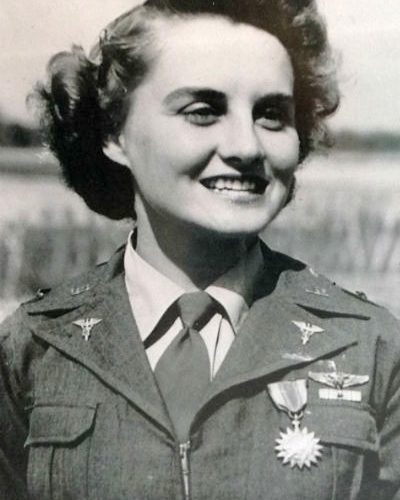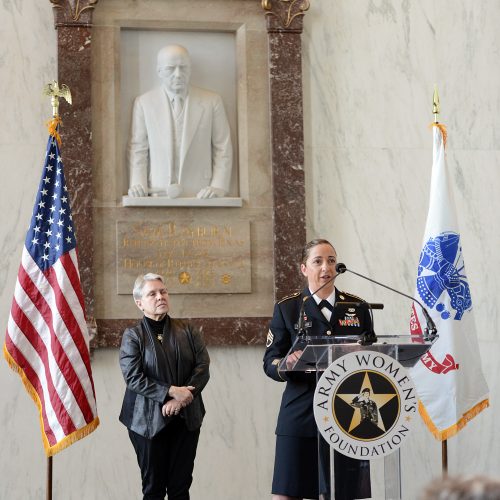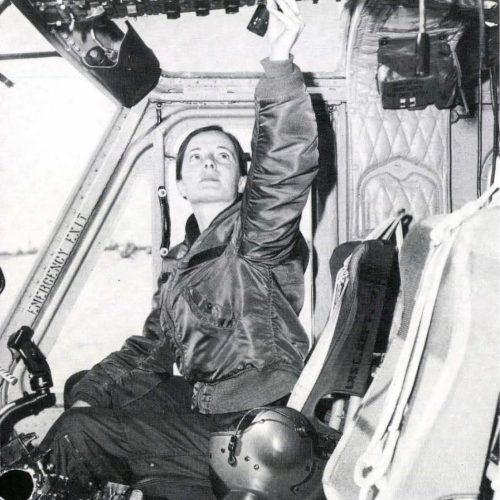INDUCTEES
Click on photo to view more information on each hall of fame inductee.

COL Jill Chambers
USA (Ret.)

CSM Mary Sutherland
USA (Ret.) - (Posthumously)
The Army Distinguished Flying Cross Recipients

"Lutz was the first army nurse to receive the Distinguished Flying Cross (posthumously, from President Franklin D. Roosevelt), Lutz was the second woman to receive the decoration (after Amelia Earhart), awarded for distinguished performance in an aerial flight. It reads as follows: For extraordinary achievement—throughout her long period of service, 1st Lt. Lutz distinguished herself through superior professional skill and courage. Her selfless devotion to duty and outstanding proficiency have reflected the highest credit upon herself and the armed forces of the United States. Her resourcefulness and determination have been on high inspiration those serving with her."
1LT Aleda E. Lutz
USA

1LT Roberta Schilbach Ross
USA

"Chief Warrant Officer 3 (CWO-3) Lori Hill, United States Army, was awarded the Distinguished Flying Cross for extraordinary achievement while participating in aerial flight while serving as Pilot of a Kiowa helicopter of the 2d Squadron, 17th Cavalry Regiment, in Support of Operation IRAQI FREEDOM on 21 March 2006 in Iraq. Chief Warrant Officer Three Hill and another helicopter were flying convoy security for two Bradley vehicles on patrol in a small village. They learned of an attack at a nearby command center involving both U.S. and Iraqi forces, so they responded to provide air support. On the way, they ran into a concentrated attack with rocket-propelled grenades and machine gunfire. They laid down suppressing fire, but the two aircraft continued. When they arrived at the command center, they were greeted with machine-gun fire, so they broke away and headed back in, shooting at the tracer fire. Drawing the fire away from the lead helo, Chief Warrant Officer Three Hill established communications with the ground troops. It provided suppressive fire for troops engaged with the enemy on the ground until they reached safety. On the third pass, a rocket-propelled grenade hit her, damaging the helo's instrumentation. As she was banking away, the helicopter took machine-gun fire, which hit Chief Warrant Officer Three Hill in the foot. The aircraft was losing transmission power and hydraulics, which prevented the copter from hovering, a crucial maneuver for landing. So, with a damaged aircraft and injury, she made an emergency landing at a nearby forward operating base, saving her crew and aircraft." (Retrieved from https://valor.militarytimes.com/hero/393194)
CW3 Lori Hill
USA

Elizabeth Will and Arthur E. Dubois designed the Distinguished Flying Cross, both working at the Army’s Institute of Heraldry. The cross symbolizes sacrifice, and the propeller represents flight. The combination of those symbols clarifies that the DFC is an award for heroism or achievement for individuals involved in aviation. The ribbon reflects the national colors. The reverse is blank and suitable for engraving the recipient’s name and rank. Subsequent awards of the Distinguished Flying Cross are indicated by oak-leaf clusters for Army and Air Force personnel and additional award stars for members of the Naval services. In World War I, aircraft proved their value for reconnaissance and as weapons platforms. Pilots of those primitive flying machines showed both courage and endurance in carrying out air missions. To recognize their gallantry, the Distinguished Flying Cross was created.
• 1st Lieutenant Aleda E. Lutz, USA
• 1st Lieutenant Roberta Schilbach Ross, USA
• Chief Warrant Officer 3 Lori Hill, USA
• Staff Sergeant Julia Stalker, USA
The awards were accepted by STAFF SERGEANT JULIA A. STALKER, USA is a Distinguished Flying Cross recipient. She served as a combat medic and deployed in support of Operation Iraqi Freedom. SSG Stalker also deployed to Afghanistan twice with the 10th Combat Aviation Brigade in support of Operation Enduring Freedom. Currently, SSG Stalker is serving as an instructor/ writer at the U.S. Army School of Aviation Medicine in Fort Rucker, Alabama.
SSG Julia Stalker
USA
Female Firsts Award



